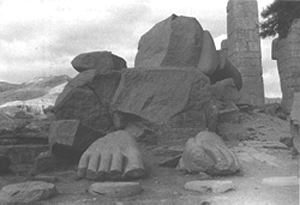
I met a traveler from an antique land Who said: Two vast and trunkless legs of stone Stand in the desert...Near them, on the sand, Half sunk, a shattered visage lies, whose from And wrinkled lip, and sneer of cold command, Tell that its sculptor well those passions read Which yet survive, stamped on these lifeless things, The hand that mocked the, and the heart that fed: And on the pedestal these words appear: "My name is Ozymandias, king of kings: Look on my works, ye Mighty, and despair!" Nothing beside remains. Round the decay Of that colossal wreck, boundless and bare, The lone and level sand stretch far away.
1. logical structure
| *Ozymandias, or Ramese II, was pharaoh of Egypt in
the thirteenth century B.C.
1. The poem, as an Italian sonnet, can be divided into two parts: the first eight lines (octave) and the next six lines (sestet). If the octave part describes the fragments of a sculpture the traveler sees on an ancient ruin, the sestet goes further to record the words on the pedestal and then describe the surrounding emptiness. How are the words on the pedestal in contrast to both the octave and the last three lines (triplet) of the poem? In other words, what does Ozymandias want to achieve, as opposed to what is left behind him? |
The feet of the colossus of Rameses II on which Shelley's poem Ozymandias is based. From Art, Space and the City p. 68. |
3. Structure of narration
The poem contains a story (told by Ozymandias) within a story (told by the
traveler) within a story (told by) the speaker of the poem). In the core of this
multiple story, the Ozymandias we know is only a sculpture and the words on it.
What does this, as well as the narrative structure, say about history and art?
Application & Wild Association![]()
![]() Different Art Forms and
Life
Different Art Forms and
Life
Consider "The Dance"(by William Carlos Williams), "Musee des
Beaux Arts," (by W. H. Auden), "Ode on a Grecian Urn"
and "Ozymandias" together.